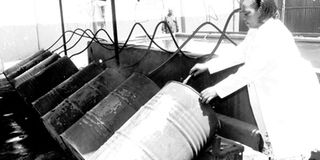First legal chang’aa distillery

Betty Wanjiru at her distillery in Mwariki Estate on the outskirts of Nakuru town where she produces her Cool One chang’aa in 250ml and 205ml packs.
A Google search of the word chang’aa will quickly produce some of the following words on linked websites; ‘kill me quick’, ‘poison brew’, or ‘African moonshine’.
The accompanying pictures will consist of dirty jerry cans, rubber pipes and barrels of the stuff being brewed in less than optimum conditions.
You will be hard-pressed to miss the classic face of the loyal chang’aa customer — unkempt hair, dry swollen lips and glazed bloodshot eyes staring back at you, and that is if they were awake when the picture was taken.
Although the government legalised chang’aa brewing in 2010 in a bid to regulate and prevent injuries and deaths, these images and words are usually what come to mind when the words chang’aa and brewing are uttered in the same breath.
Chang’aa has a bad rap, and for good reason — cases of the brew being laced with methanol and even jet fuel are numerous, and the chances of it being brewed in unhygienic conditions are high — reports of dead rats and women’s underwear being found at the bottom of the barrels abound.
TEDIOUS PROCESS
This year alone, more than 90 people have died after consuming illegally brewed liquor, a category in which chang’aa squarely falls.
But, despite its critics and poor public image, the brew, if prepared legally, can be a source of livelihood for those willing to go down the oft-disparaged path of distilling it.
For Betty Wanjiru, who started by illegally brewing chang’aa in 1997, it has been a long and difficult journey. “It was a tedious process when I first began to make chang’aa, quenching customers’ alcohol thirst with a drink whose safety I wasn’t even sure of while still sharing my profits with hungry police,” she recalls.
Wanjiru, who was born and bred in Maji Mazuri, Koibatek, says this was the only source of livelihood for her cash-strapped family. “I grew up in a very poor family.
“My father was polygamous and taking care of all of us was quite difficult, so our mother decided to brew chang’aa to take care of us.”
FAMILY INCOME
In 1990, the year Wanjiru completed high school, her mother stopped brewing the then illegal alcoholic drink to supplement the family income, Wanjiru started doing casual jobs.
But that did not go well because the wages were low, and so in 1997 she followed her mother’s footsteps into the brewing business. To find stronger footing, she left her rural Maji Mazuri home and settled in Nakuru.
At about the same time, chang’aa was in the news for all the wrong reasons; it had caused havoc in various parts of the country, killing or blinding scores.
Police and provincial administrators took advantage of the situation and started extorting bribes from her and other traders, which resulted in loss of revenue.
However, the worst was yet to come, as in 2012 she was arrested for running an unlicensed business during a raid led by the then Nakuru District Commissioner Kang’ethe Thuku. As a result, she says she lost brewed products worth Sh900,000 and raw materials worth Sh400,000.
NEW LEGAL FRAMEWORK
“That was too much for me to bear, and that’s when I started the tedious journey to license my business,” she says. She approached the District Alcoholic Drinks Committee but was told to get “a better job”.
She did not listen to them, and today Wanjiru is the first entrepreneur to be licensed by the National Authority for Campaign against Alcohol and Drug Abuse (Nacada) to brew and package the controversial drink under its new legal framework.
The BetPet director, who proudly displays the Nacada licence signed by acting CEO Enock Onchwari, now manages an investment worth Sh3 million.
We found her at Mwariki Estate on the outskirts of Nakuru town, where she proudly showed us around her distillery. Her Cool One chang’aa is currently packed in 250ml and 205ml packs — both glass and plastic — but the director says she plans to introduce a 750ml pack.
According to Article 57 of the Alcoholic Drinks Control Act, 2010, all alcohol manufacturers should obtain a Certificate of Analysis after their products have been approved.
FACILITY'S CAPACITY
That is achieved by sending sample drinks for testing, which Nacada chair John Mututho says aims to achieve safety and compliance with the authority’s directives.
“Every manufacturer must have a Certificate of Analysis from Nacada, which approves all alcohol components. We’re yet are to issue those certificates because we are still testing samples that were sent to us,” said Mututho.
According to the KRA certification in her possession, Wanjiru is authorised to produce 12,000 litres of chang’aa annually due to her facility’s capacity and the terms of the licence she applied for, but she says that the demand is rising, so she plans to review her licence with KRA and expand her production capacity.
Wanjiru said her samples were tested and approved by the relevant government agencies, but adds that she is still waiting for the Kenya Bureau of Standards (Kebs) to issue her with a Certificate of Analysis for her product.





